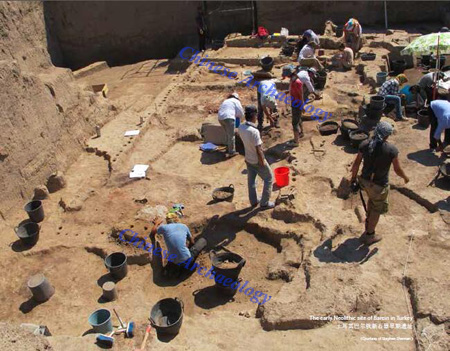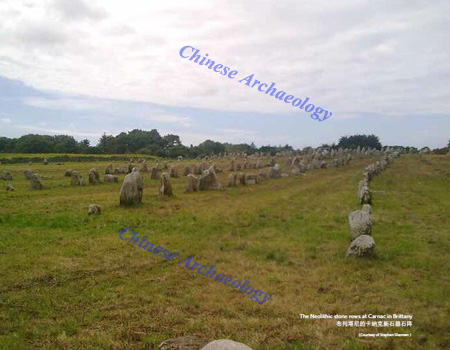Cultural Evolution of Neolithic Europe
From:Chinese Archaeology NetWriter:Stephen ShennanDate:2015-12-24
Archaeology’s strengths as a discipline derive from its ability to identify broad patterns and processes in space and time on the basis of demonstrable evidence. But its goals cannot be achieved without a theoretical perspective that suggests what is important and why. The aim of the EUROEVOL project was to explain the patterns of stability and change associated with the spread and establishment of farming in Neolithic Europe in the light of perspectives on the workings of human cultures and societies derived from the ever growing development and application of evolutionary theory in the social sciences, and in particular population ecology and life history theory. In this light the main focus of the project was on population patterns and processes. Did the appearance of farming in Europe drive major population increases resulting from improved survival and reproductive success, as predicted, for example, by the idea of the Neolithic Demographic Transition, and, if so, what were the consequences? In order to answer this question we needed to create a reliable measure of past population sizes over the long-term and on a large spatial scale, taking into account into account the shortcomings of the archaeological record. As the basis for doing this the project created a spatial database of over 14,000 radiocarbon dates from archaeological sites for the period from 8000-4000 BP in western and central Europe, covering the last two millennia when foragers were prevalent and the first 2-3 millennnia of farming societies, for temperate Europe, all the way from Ireland in the west to Poland in the east. This unparalleled coverage made it possible to draw large-scale comparisons over space and time.Archaeologists have been using summed radiocarbon date probabilities for some time as the most sensitive indicator of prehistoric population patterns but the method has been criticised on a number of grounds. We substantiated our claims by comparing our inferences with those based on other lines of evidence, especially evidence from pollen cores of human impact on the environment. In addition, we developed completely novel quantitative methods to use the radiocarbon dates as a robust measure of changing population size, taking into account variation produced by sampling effects and the radiocarbon calibration curve, and to test the hypothesis that farming led to regional population growth when and where it was adopted; we carried out this analysis for 24 different regions. We then used available data on climate patterns to see if there was any connection between population and climate.

The early Neolithic site of Barcin in Turkey
As well as the radiocarbon data, we also collected information on large numbers of archaeobotanical and archaeofaunal assemblages at the same spatial scale, together with data on pottery assemblages and on the incidence of flint-mining, monument construction and outbreaks of violence. This enabled us to investigate whether subsistence patterns, cultural patterns, the construction of monuments, the incidence of violence and the digging of flint mines were related to the population patterns. We also addressed long-standing questions concerning the way that patterns in pottery, projectile points, faunal assemblages and crop preferences change across space and time, and the factors that affect this, for example, whether similarities and differences between sites can be explained simply by how distant they are from one another in space and time. This work involved the novel application of statistical methods from population genetics to archaeological questions.
The project’s most important conclusion is that the introduction of farming to Europe did not lead to a steady improvement in living conditions and ongoing population increase, but was characterized by a pattern of ‘boom’ and ‘bust’ in many regions; even in regions without dramatic ‘busts’ there were often longer term population declines. Because farming arrived at different times in different regions the ‘booms’ and ‘busts’ were not all contemporary with one another, but there was a consistent local pattern of growth to a population peak over 300-400 years, followed by an often dramatic decline. Our initial analyses did not find evidence that these patterns could be accounted for by climate change, suggesting that it was internal factors in these early societies that led to them exceeding the sustainable limits of their socioeconomic systems. Subsequent work on our part, together with Oceanography colleagues, suggests that there might be a climate impact in some cases, amplifying the effects of internal processes. In any case, we found correlations between the population patterns and changing patterns in the subsistence economy, for example the exploitation of larger proportions of wild fauna at times of lower population; and that mining of raw materials like flint for exchange was most prevalent when regional populations were at their height. More strikingly perhaps, we found strong evidence across several different regions that investment in the construction of conspicuous earthwork monuments that would have required a great deal of labour coincided with periods of high local population, suggesting not just that they marked territorial claims but were also instances of ‘costly signalling’. This is a well-known evolutionary process in which individuals or groups publicly advertise their strength, which might not otherwise be obvious, to their competitors. Study of the occurrence of large-scale Neolithic violence events, such as massacres, showed that these too had a significant correlation with a particular feature of the regional population patterns, occurring after the peak, when population was beginning to decline; thus, violence outbreaks appear to be associated with societies exceeding their demographic and economic limits, a pattern that the evolutionary anthropologist Peter Turchin has also identified in other contexts. The results make a point very relevant to today: there is no guarantee of a smooth levelling out of world population levels when they reach their peak.

The Neolithic stone rows at Carnac in Brittany
As noted above, a separate thread of work focussed in detail on the nature of the cultural transmission processes at work in the Neolithic, and in particular whether the named archaeological cultures long used by scholars to categorise material have any meaning in terms of influence on people’s activities and practices in the past. Our studies of faunal and botanical evidence, for example, found that patterns of species exploitation at the sites studied could not simply be accounted for by local environmental factors, but were also correlated with the cultural affiliation of the site, indicating that cultural boundaries in space and time influenced the nature of subsistence practices; for example certain crops were preferred by certain cultures. In other words, even in the case of subsistence patterns we cannot assume that the environment explains everything: histories of cultural transmission matter.
The great majority of the substantive results outlined above have been achieved through novel methodological developments that take the application of quantitative methods in archaeology to new levels of sophistication and represent another main achievement of the project. As we hoped, the methods are now being applied by others, while our substantive demographic results are beginning to be cited by geneticists and environmental scientists interested in human population history.
Finally, a key aspect of the project has been making both the results and the data available to all. The great majority of the published papers are open access. The radiocarbon, archaeobotanical and archaeofaunal databases have been placed in UCL’s public research repository and all other data used in publications is available in the form of online supplements to the papers. Archaeologists haven’t always been keen to share their data promptly but this is very important for the future development of the discipline.
I’m most grateful to the team of post-doctoral researchers whose outstanding abilities and efforts made the project a success – Sue Colledge, Katie Manning, Enrico Crema, Adrian Timpson, Tim Kerig, Kevan Edinborough and Sean Downey – and to the European Research Council Advanced Grants #249390.
Stephen Shennan
Stephen Shennan is Professor of Theoretical Archaeology at the UCL Institute of Archaeology, where he was Director from 2005 to 2014. He did his undergraduate degree in Archaeology and Anthropology at the University of Cambridge, where he also did his PhD, supervised by David Clarke. After Cambridge he held teaching positions at the University of Southampton before moving to University College London in 1996. He is a specialist in European prehistory but since the late 1980s his interests have been mainly focussed on exploring the use of method and theory from the study of biological evolution to understanding cultural stability and change, with a particular focus on the role of demographic factors. He has published over 100 papers and over 20 authored and edited books; they include Quantifying Archaeology (2nd edition 1997), Genes, Memes and Human History (2002), Pattern and Process in Cultural Evolution (edited, 2009), and most recently Connecting Networks: characterising contact by measuring lithic exchange in the European Neolithic (2015, co-edited with Tim Kerig). He is a Fellow of the British Academy and a member of the Academia European; he was awarded the Rivers Medal of the Royal Anthropological Institute in 2010.
(Stephen Shennan University College London)
(Source: Research Center for World Archaeology, Shanghai Academy)

